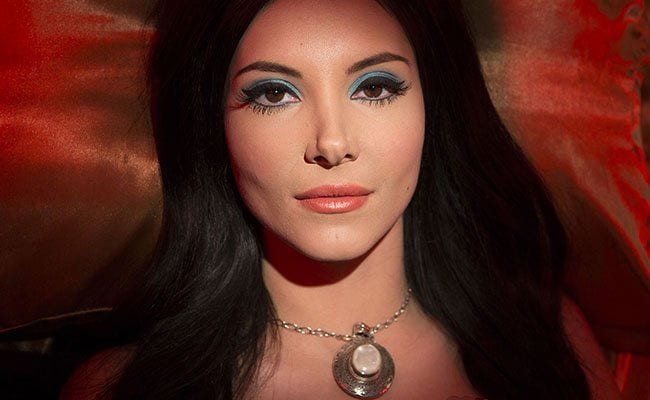
Shot in beautiful retro style, Anna Biller’s The Love Witch depicts Elaine (Samantha Robinson) as a modern-day witch who uses magic to find heterosexual love — despite the fact that the men she meets are not quite up to the challenge. Continually disappointed in men’s inability to truly love women, Elaine must go deeper into her quest for romance; in so doing, she leaves behind her a trail of murder and chaos.
The film opens with Elaine explaining her past in voice-over. In this segment two things stand out: the film’s aesthetics and its frank engagement with gender politics and feminism. Drawing influence from older horror films, everything from the mise-en-scène to the use of rear-projection look as though they were lifted straight from a giallo film. The Love Witch is successfully made to look like it was generated in Technicolor, while lighting is done in an expressive way, alternating between bright illumination and glowing spotlights during flashbacks. Even the actors’ mannerisms mimic the theatrical affect one is used to in older classic films, thus creating a strikingly beautiful and meticulously fashioned period style.
Elain’s search for love never shies away from the realities of male abuse. Within the first two minutes, Elaine tells us of her history of trauma, as she recalls her nervous breakdown and her therapist’s advice for recovery. Bluntly and immediately, Biller presents the reality of heterosexuality within a film intent on glamorizing the artificiality of film’s history, contrasting significantly the condemnation of real-life violence and oppression with the pleasure of cinematic spectacle. Prescient feminist issues are brought together with problematic cinephilia to expand upon horror nostalgia. Biller never abandons her interest in the past, but also never subjugates her film and its politics to its outdated standards.

However, the major issue within The Love Witch is the politics, in that they end up becoming relatively simple. Issues of abuse, trauma, and the difficulty of recovery are examined explicitly and through metaphor and fantasy. At the same time, issues of oppression can be forgotten amongst the fun, candy-coloured narrative. Beginning with the story of a woman moving past her abuse, we turn to a fantasy of female empowerment gone wrong, where a desire for love leads to murdering men who are incapable of providing love. Though never losing its central thesis that these men cannot love or respect women, The Love Witch does lose its exploration of the severity of this problem. Where the film initially deals with real-world abuse, it ends with psychedelic sequences where Elaine is simply romantically unfulfilled, thus trivializing the gravity of oppression.
Despite what starts as an in-depth exploration of violence and dehumanization, at the crux of the film is the idea that women can use their sexuality and beauty to get what they want. Elaine seduces man after man in colourful spectacles, while her friends discuss the subversive power of feminine sensuality. There’s a bit of pushback, however: despite any power gained, women will never truly be loved by these men because they hate women. Yet this is part of the issue. There’s no real critique of the idea of sex being empowering, instead it’s a critique of how misogyny makes men inaccessible. Thus, the film lacks self-awareness in its simplistic sex-positivity.
The examination of sexuality and misogyny is a start, but a shallow one, for women using sex to get what they want is not that empowering, as the women remain sex objects. Further, it ignores women who are not privileged like Elaine or the women surrounding her — beautiful and valuable by heteropatriarchal standards. It equally ignores women who don’t want to use sex with men as a means to gain power, and women who are not sexually attracted to men in the first place. Biller is interested in only a very narrow definition of female empowerment, and doesn’t acknowledge that women are not a monolith, and that oppression and radical reaction are not singular.

Elaine (Samantha Robinson) and Griff (Gian Keys)
The Love Witch is certainly a good film, especially in terms of its aesthetics. However, its reductive politics diminish its impact. Although the film brings up some complex ideas on gender, empowerment, and misogyny, by the end one feels that an interesting conversation has been halted. The aesthetics of the film are perfected, while its cultural critique never moves beyond basics. With a two-hour run-time, one hopes to begin to get beyond the same tired concept of feminism defined by women’s relationships with men.
Ultimately, though, The Love Witch is a complicated work, and despite a relatively shallow social consciousness, it would be a shame to miss such a sincerely magnetic film. The initiation of an incomplete feminist conversation can leave the spectator feeling unsatisfied, but only because everything else is so refined and intelligent that the discourse should match. The Love Witch is a highly enjoyable, well-made film, but it’s smart enough that its downfalls are disappointing; its potential is clear, and it’s evident that it could have delved further into the feminist ideology it only begins to present.

